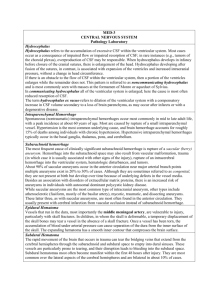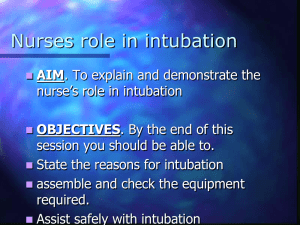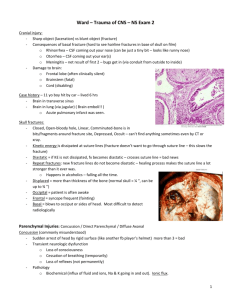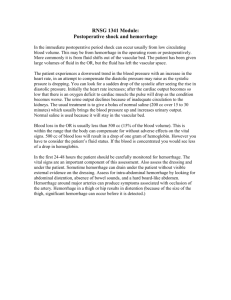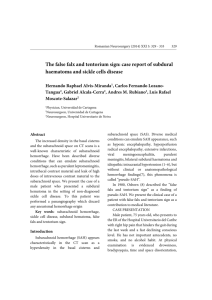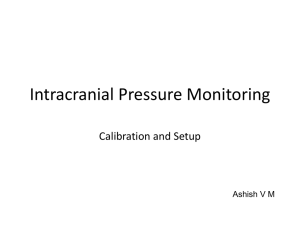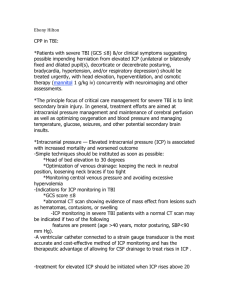SAH Case - EM Sim Cases
advertisement
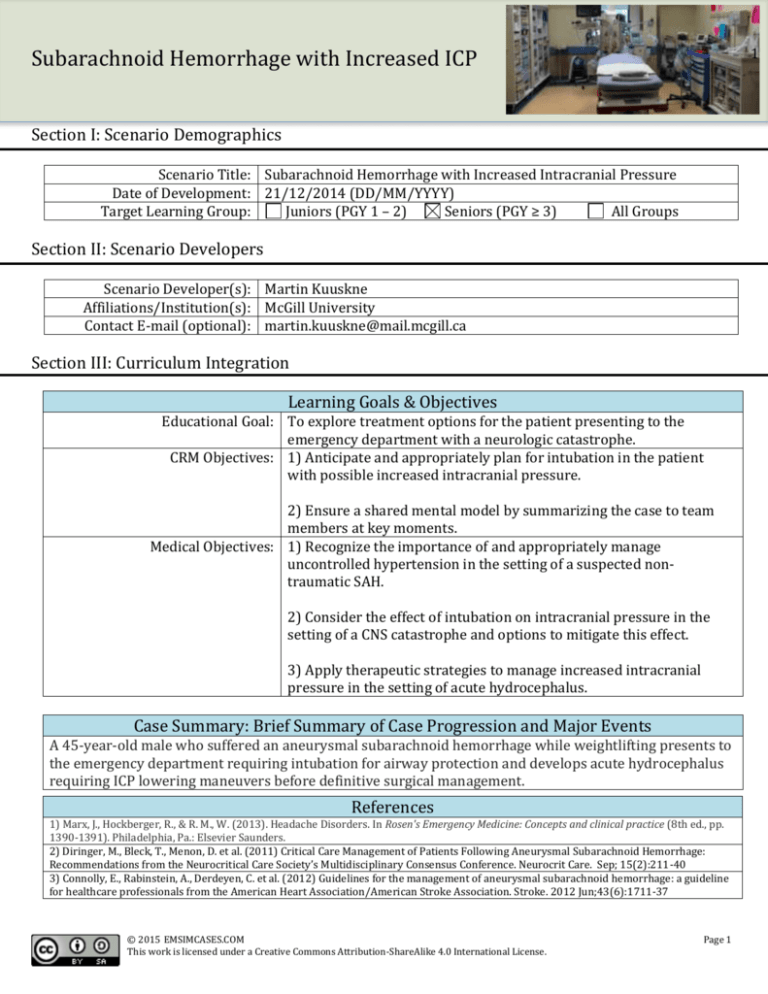
1 Subarachnoid Hemorrhage with Increased ICP Section I: Scenario Demographics Scenario Title: Subarachnoid Hemorrhage with Increased Intracranial Pressure Date of Development: 21/12/2014 (DD/MM/YYYY) Target Learning Group: Juniors (PGY 1 – 2) Seniors (PGY ≥ 3) All Groups Section II: Scenario Developers Scenario Developer(s): Martin Kuuskne Affiliations/Institution(s): McGill University Contact E-mail (optional): martin.kuuskne@mail.mcgill.ca Section III: Curriculum Integration Learning Goals & Objectives Educational Goal: To explore treatment options for the patient presenting to the emergency department with a neurologic catastrophe. CRM Objectives: 1) Anticipate and appropriately plan for intubation in the patient with possible increased intracranial pressure. 2) Ensure a shared mental model by summarizing the case to team members at key moments. Medical Objectives: 1) Recognize the importance of and appropriately manage uncontrolled hypertension in the setting of a suspected nontraumatic SAH. 2) Consider the effect of intubation on intracranial pressure in the setting of a CNS catastrophe and options to mitigate this effect. 3) Apply therapeutic strategies to manage increased intracranial pressure in the setting of acute hydrocephalus. Case Summary: Brief Summary of Case Progression and Major Events A 45-year-old male who suffered an aneurysmal subarachnoid hemorrhage while weightlifting presents to the emergency department requiring intubation for airway protection and develops acute hydrocephalus requiring ICP lowering maneuvers before definitive surgical management. References 1) Marx, J., Hockberger, R., & R. M., W. (2013). Headache Disorders. In Rosen's Emergency Medicine: Concepts and clinical practice (8th ed., pp. 1390-1391). Philadelphia, Pa.: Elsevier Saunders. 2) Diringer, M., Bleck, T., Menon, D. et al. (2011) Critical Care Management of Patients Following Aneurysmal Subarachnoid Hemorrhage: Recommendations from the Neurocritical Care Society’s Multidisciplinary Consensus Conference. Neurocrit Care. Sep; 15(2):211-40 3) Connolly, E., Rabinstein, A., Derdeyen, C. et al. (2012) Guidelines for the management of aneurysmal subarachnoid hemorrhage: a guideline for healthcare professionals from the American Heart Association/American Stroke Association. Stroke. 2012 Jun;43(6):1711-37 © 2015 EMSIMCASES.COM This work is licensed under a Creative Commons Attribution-ShareAlike 4.0 International License. Page 1 2 Subarachnoid Hemorrhage with Increased ICP Section IV: Scenario Script A. Clinical Vignette: To Read Aloud at Beginning of Case You are working an evening shift at a tertiary care centre emergency department with full surgical capabilities. A patient is brought into the resuscitation area by ambulance with decreased mental status. B. Scenario Cast & Realism Patient: Computerized Mannequin Mannequin Standardized Patient Hybrid Task Trainer Realism: Conceptual Physical Emotional/Experiential Other: N/A Select most important dimension(s) Confederates Brief Description of Role N/A N/A. C. Required Monitors EKG Leads/Wires NIBP Cuff Pulse Oximeter Temperature Probe Defibrillator Pads Arterial Line Central Venous Line Capnography Other: D. Required Equipment Gloves Stethoscope Defibrillator IV Bags/Lines IV Push Medications PO Tabs Blood Products Intraosseous Set-up Nasal Prongs Venturi Mask Non-Rebreather Mask Bag Valve Mask Laryngoscope Video Assisted Laryngoscope ET Tubes LMA Scalpel Tube Thoracostomy Kit Cricothyroidotomy Kit Thoracotomy Kit Central Line Kit Arterial Line Kit Other: Other: E. Moulage Gym attire for mannequin. F. Approximate Timing Set-Up: 5 min Scenario: 12 min Debriefing: 15 min © 2015 EMSIMCASES.COM This work is licensed under a Creative Commons Attribution-ShareAlike 4.0 International License. Page 2 3 Subarachnoid Hemorrhage with Increased ICP Section V: Patient Data and Baseline State A. Patient Profile and History Patient Name: Philip Yates Age: 45 Weight: 100kg Gender: M F Code Status: Unknown Chief Complaint: Altered Mental Status History of Presenting Illness: The patient was at the gym lifting weights; he complained of a headache to his friend and suddenly fell to the ground. The patient remained unconscious with sonorous breathing. The ambulance was called. Past Medical History: HTN Medications: Bisoprolol 5mg PO QD Dyslipidemia Atorvastatin 40mg PO QD T2DM Metformin 500mg PO BID Allergies: NKDA Social History: ½ PPD smoker, recreational EtOH, no Hx of illicit drug use. Family History: Non-contributory Review of Systems: <Unable to obtain review of systems history from patient> B. Baseline Simulator State and Physical Exam No Monitor Display Monitor ON, no data displayed Monitor ON Standard Display HR: 110/min BP: 198/102 RR:8/min O2SAT: 95 % o T: 36.9 C Glucose: 10 mmol/L GCS: 7 (E2-pain V2-sounds M4-withdraws) General Status: Altered, somnolent, decreased responsiveness CNS: Pupils 3mm bilaterally, minimally responsive. Gaze preference to right. Unable to test upper & lower extremity strength/sensation, but not moving left upper extremity. +Babinski reflex on left. 3+ reflexes on left side. HEENT: Normal. CVS: Tachycardia, no extra heart sounds, normal peripheral pulses. RESP: Bradypneic, GAEB ABDO: Normal GU: Normal MSK: Normal, neurologic findings as above SKIN: Normal © 2015 EMSIMCASES.COM This work is licensed under a Creative Commons Attribution-ShareAlike 4.0 International License. Page 3 4 Subarachnoid Hemorrhage with Increased ICP Section VI: Scenario Progression Scenario States, Modifiers and Triggers Patient State 1. Baseline State Rhythm: Sinus Tach HR: 110/min BP: 200/102 RR: 8/min O2SAT: 95 % T: 36.9oC 2. Intubation O2SAT 99% RR 12 Display (if possible) - ETCO2 = 48 - FiO2; 1.0 - Tv: 500mL - PEEP: 5 3. Hydrocephalus HR 55 over 1 minute BP 220/112 Patient Status GCS: 7 (E2-pain V2-sounds M4withdraws) Minimally responsive/ somnolent Pt paralyzed post intubation and sedated. Posturing movements (if succinylcholine used as paralytic agent) Right pupillary dilatation 4. Resolution HR 80 over 30 seconds BP 160/96 Learner Actions, Modifiers & Triggers to Move to Next State Learner Actions Modifiers Changes to patient condition based on - Monitors/Full vitals learner action - Physical exam (+Neuro) - IV anti-hypertensive 1st bolus - IV Access Δ BP to 187/106 - Laboratory Investigations - IV anti-hypertensive 2nd bolus - IV anti-hypertensive or infusion Δ BP to 155/95 - EKG - Pre-treatment Triggers - Induction medication For progression to next state - Paralytic medication - Intubation 2.Intubation - Intubation - 5 minutes 3.Hydrocephalus Learner Actions Modifiers - Confirmation of tube - OG tube - Post-intubation CXR Triggers - 2 minutes3.Hydrocephalus Learner Actions - Elevate head of bed - Hyperventilation - Mannitol 1gm/kg of 20% = 500ml - Hypertonic Saline 3% 250ml bolus - Neurosurgical consult for EVD Modifiers - Hyperventilation ΔETCO2 to 35 and ΔRR accordingly Learner Actions - CT head - ICU consultation - ± Nimodipine 60 mg OG - ± Seizure prophylaxis - ± Tranexamic Acid 1g IV END SCENARIO Triggers - ≥2 ICP lowering methods 4.Resolution © 2015 EMSIMCASES.COM This work is licensed under a Creative Commons Attribution-ShareAlike 4.0 International License. Page 4 5 Subarachnoid Hemorrhage with Increased ICP Section VII: Supporting Documents, Laboratory Results, & Multimedia Laboratory Results VBG pH: 7.29 PCO2: 62 PO2: 45 HCO3: 23 © 2015 EMSIMCASES.COM This work is licensed under a Creative Commons Attribution-ShareAlike 4.0 International License. Lactate: 1.8 Page 5 6 Subarachnoid Hemorrhage with Increased ICP Section VIII: Debriefing Guide General Debriefing Plan Individual Group With Video Without Video Objectives Educational Goal: To explore treatment options for the patient presenting to the emergency department with a neurologic catastrophe. CRM Objectives: 1) Anticipate and appropriately plan for intubation in the patient with possible increased intracranial pressure. 2) Ensure a shared mental model by summarizing the case to team members at key moments. Medical Objectives: 1) Recognize the importance of and appropriately manage uncontrolled hypertension in the setting of a suspected non-traumatic SAH. 2) Consider the effect of intubation on intracranial pressure in the setting of a CNS catastrophe and options to mitigate this effect. 3) Apply therapeutic strategies to manage increased intracranial pressure and acute hydrocephalus Sample Questions for Debriefing 1) 2) 3) 4) 5) 6) What made the intubation especially important in this case? What are examples of optimal times to summarize the case for your team? What are risk factors for rebleeding in non-traumatic SAH? What is the target systolic BP in SAH? What can you use to achieve this target? What are signs of acute hydrocephalus? List management strategies for acute hydrocephalus Key Moments 1) Peri-intubation 2) Cushing’s response for increased ICP 3) Prioritizing options in ICP management; what to give first? © 2015 EMSIMCASES.COM This work is licensed under a Creative Commons Attribution-ShareAlike 4.0 International License. Page 6
